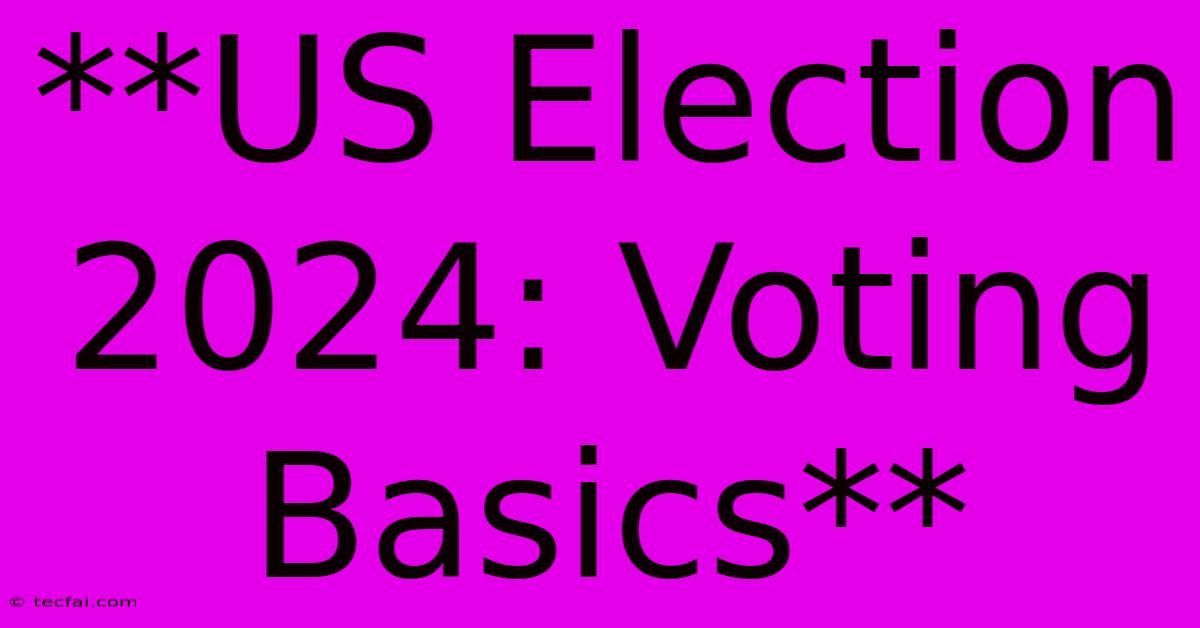**US Election 2024: Voting Basics**

Discover more detailed and exciting information on our website. Click the link below to start your adventure: Visit Best Website tecfai.com. Don't miss out!
Table of Contents
US Election 2024: Voting Basics - Your Guide to Making Your Voice Heard
The 2024 US Presidential Election is on the horizon, and with it comes the opportunity for every eligible citizen to participate in shaping the future of the country. Whether you're a seasoned voter or casting your ballot for the first time, understanding the voting basics is crucial. This guide will walk you through the essential steps to ensure your vote is counted and your voice heard.
1. Register to Vote: The First Step
Before you can cast your ballot, you must be registered to vote. The process varies by state, but generally involves providing basic information like your name, address, and date of birth.
- Deadlines: Be aware of the voter registration deadlines in your state. These deadlines may differ for primary elections and the general election.
- Online Registration: Many states offer online voter registration, making the process convenient.
- In-Person Registration: You can also register in person at designated locations, often at government offices or libraries.
2. Know Your Voting Options: In-Person vs. Absentee
The United States offers various voting options, allowing you to choose the method that best suits your needs:
- In-Person Voting: This is the most common method, where you visit your designated polling place on Election Day.
- Absentee Voting: Also known as mail-in voting, this option allows you to cast your ballot by mail before Election Day. Absentee voting may require providing a specific reason, depending on your state.
- Early Voting: Some states offer early voting periods, where you can cast your ballot in person at designated locations before Election Day.
3. Understand the Election Process: From Primaries to General Election
The US election process is complex, involving multiple stages:
- Primary Elections: Held in each state, primary elections allow registered voters to choose their preferred candidate for each political party.
- Caucuses: Similar to primaries, caucuses are a more interactive and participatory process where voters gather and discuss candidates before making a decision.
- General Election: This is the main election where voters choose the president and other elected officials.
4. Research the Candidates: Make an Informed Decision
Voting is a crucial right and responsibility. Before casting your ballot, take the time to research the candidates and their positions on issues that matter to you.
- Candidate Websites: Visit each candidate's website to learn about their platform, policies, and experience.
- Independent Resources: Utilize reliable and unbiased resources like fact-checking websites and non-partisan organizations to get accurate information.
- Local Events and Debates: Attending candidate forums, debates, or town hall meetings allows you to hear the candidates speak directly and ask questions.
5. Election Day Essentials: What to Bring
On Election Day, ensure you have the following:
- Valid Photo ID: Bring a government-issued photo ID, such as a driver's license or passport.
- Know Your Polling Place: Confirm your polling place location before Election Day to avoid confusion.
- Understand Your Ballot: Familiarize yourself with the ballot before arriving at the polling place.
Conclusion
Voting is a fundamental right and a cornerstone of democracy. By understanding the basics of the US election process, you can actively participate in shaping the future of the country. Register to vote, choose your voting method, research the candidates, and make your voice heard. Every vote counts, and your participation plays a vital role in shaping the future of the United States.

Thank you for visiting our website wich cover about **US Election 2024: Voting Basics**. We hope the information provided has been useful to you. Feel free to contact us if you have any questions or need further assistance. See you next time and dont miss to bookmark.
Featured Posts
-
Rfk Jr Fluoride Proposal Gets Trumps Nod
Nov 05, 2024
-
Mens Basketball Falls To 7 Duke
Nov 05, 2024
-
Where To Vote In Person Or Drop Off
Nov 05, 2024
-
Successful 2024 C And I Expo In Melbourne
Nov 05, 2024
-
Who Will Win The Presidential Election
Nov 05, 2024
